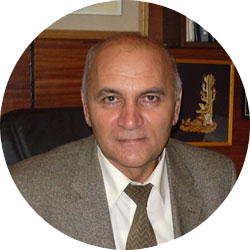USSR Author’s Certificate # 1719316, 17.10.1986.
Bakhir V.M., Spektor L.Ye., Zadorozhny Yu.G., Lysenko N.M., Rudinsky Ya.A.
Experiments show that in the process of electrochemical transformation of diluted solutions in flow-through electrochemical reactors, there occurs significant differential pressure on the diaphragm, and if the diaphragm is made of materials such as belting, tarpaulin, chlorine, open-porous polyethylene, mipor, miplast, naphyon and other polymer materials, its deformation results in changes of electrode chamber configuration, which has a distinctly negative effect on the parameters of electrochemical exposure. It was decided to improve flow-through diaphragm-type electrochemical reactors by designing rigid structures with ceramic diaphragms. Electrochemical reactors with diaphragms made of various ceramic materials whose inner diameter ranged between 20 and 150 mm, wall thickness from 2.5 to 6.0 mm, and length between 200 and 450 mm, were tested. Experiments established the optimal ratio of anode and cathode diameters, the width of electrode chambers (the distance between electrode surface and diaphragm) and their length in the above indicated range of sizes, the material of electrode and diaphragm being the same as in the experiment.
The given experiment is crucial, because it outlined the main direction of developing the design of flow-through diaphragm-type electrochemical reactors for unipolar treatment of water and diluted aqueous electrolyte solutions in the period between 1985 and 1989. The subject of the invention is a diaphragm-type flow-through reactor in the form of an electrode – monoblock, with in-built co-axially mounted counter electrodes and ceramic diaphragms. Anodes in these reactors were made of carbon coated by manganese dioxide or titanium coated by ruthenium oxide; cathodes – from carbon (solid graphite), diaphragms – from ceramics based on aluminum oxides, later – from zirconium oxide ceramics. The area of a single anode was 25-40% smaller than that of cathode and was 0.01-0.02 m2. Total electrode surface in an individual reactor achieved 1.0 m2. The said reactors, unlike those developed earlier, were capable of working in conditions of considerable differential pressure on the diaphragm. Systems designed at that time featured greatly improved specific performance characteristics of electrochemical reactors with considerable reduction of their weight and dimensions. Full-scale production of such systems revealed their high efficiency and further widened the scope of electrochemical activation technologies’ application extending to such spheres as, for instance, electronic industry, where technological processes require de-ionized (distilled) water.
This type of electrochemical reactor had no analogues, and represented the third generation of flow-through diaphragm-type reactors with co-axially installed electrodes and diaphragms. It was used in many devices manufactured on a large scale:
ELCA-003, first modifications of REDOX device for cleaning artificial kidney dialyzers, first modifications of ECATRON devices for poultry farms and ECATRON-K for straw saccharification, first modifications of ELF devices for food industry and some others.
Use of ceramic diaphragms solved many difficult problems, but it gave rise to electro-osmosis problem, that is, electro-osmotic transfer of liquids through a porous hydrophilic diaphragm. Electro-osmotic transfers significantly complicated development of electrochemical systems with a closed volume of slowly replenished auxiliary electrolyte.
